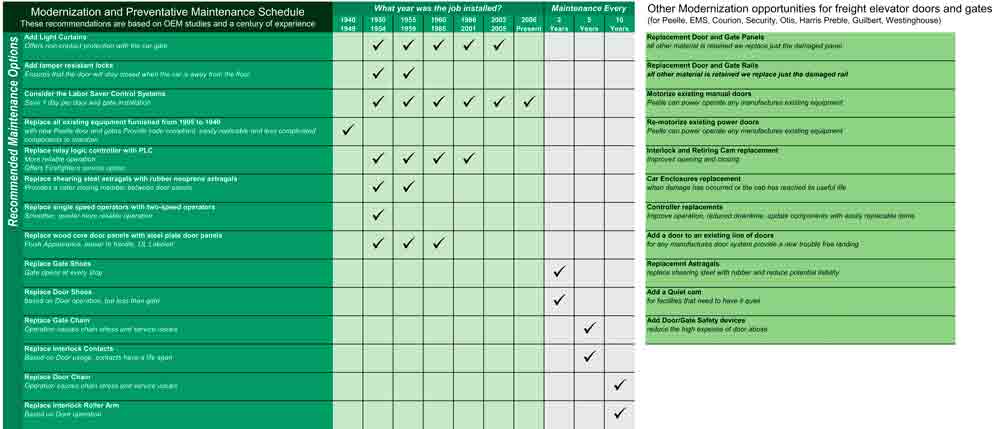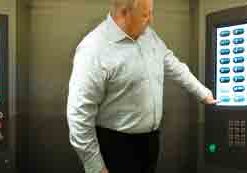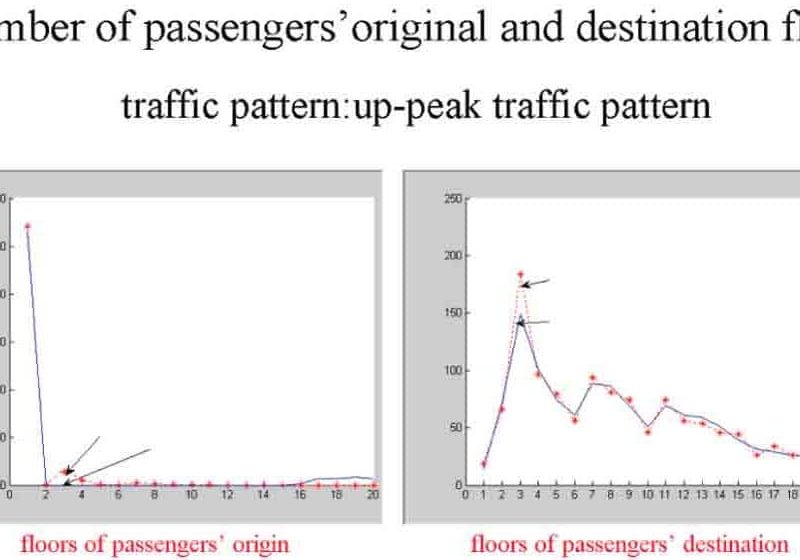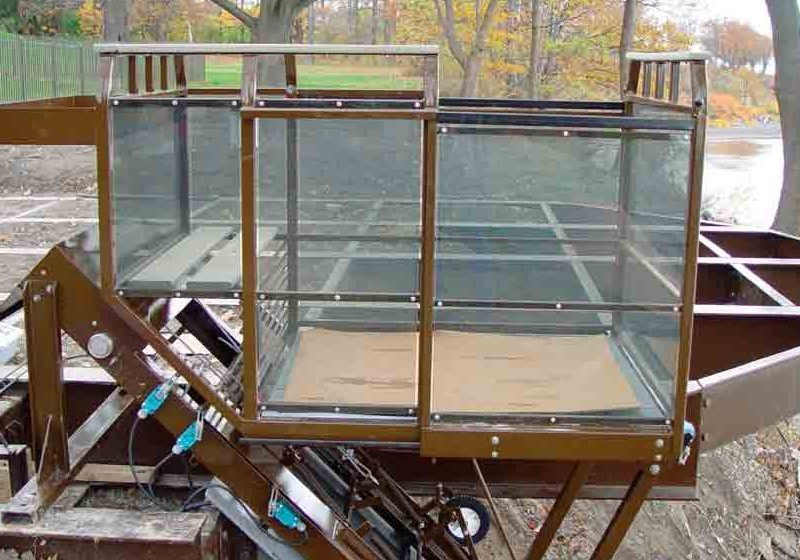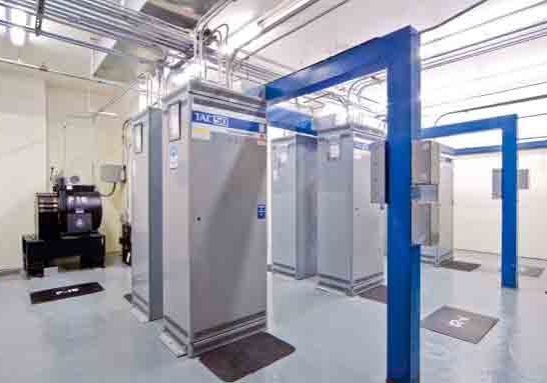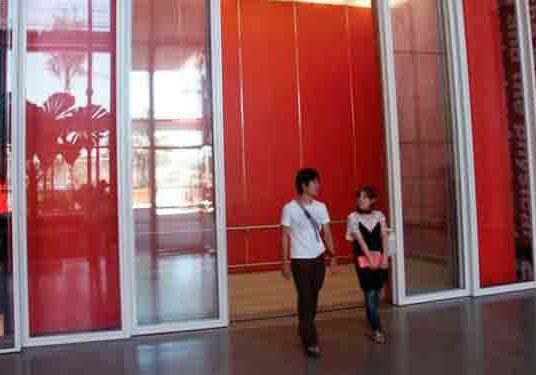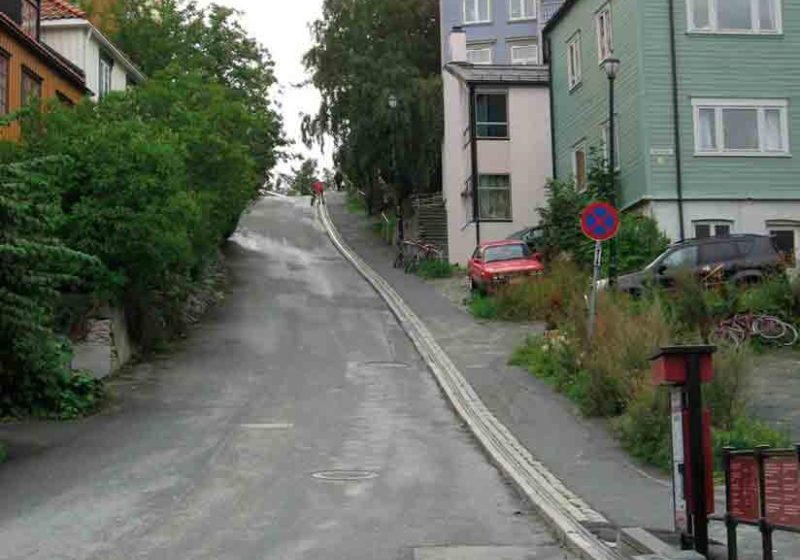A brief history of the freight-elevator biparting door, in addition to why and how they should be modernized
Freight elevator hoistway doors are traditionally robust due to their heavy-duty purpose, i.e., taking abuse from users, trucking needs, operating in extreme temperatures, and opening and closing multiple times during work shifts. Indeed, it is not uncommon for hoistway doors to outlive other elevator components. What wasn’t anticipated by early designers of freight doors is that, with proper maintenance and care, the products’ lifecycles could span decades. Although this provides value for owners, it has created an abundance of installations that properly operate but are in need of modernization. Though equipment may be grandfathered with respect to the American National Standards Institute code due to original installation dates, the need for updating components may still exist. One example is the steel meeting angle between the upper and lower door panels.
Although steel astragals were removed from the code in 1955, installations that still include them present a shearing hazard. Today, a resilient neoprene astragal is furnished between the upper and lower panels. Car-gate reversing edges make up another example. Although they were designed correctly and may operate properly, they still require an object to make contact with the reversing edge to signal a reverse; since their inception, these edges have been replaced with at least one light curtain (as the most current code requires two light curtains).
This situation poses the question, “What would it take to modernize properly operating, potentially code-compliant (due to grandfathering), non-updated freight elevator door equipment?” Most contractors return to the OEM, though many are no longer in business and several manufactures have discontinued freight elevator door manufacturing. To address this need, the Peelle Co. has developed modernization products suited for any manufacturer’s equipment.
History
A pioneer of the freight elevator bi-parting door, Peelle has a 107-year-plus history of product installations. Much Peelle equipment built before the 1980s remains in service and is overdue for modernization, and not just due to code changes, but also because the products have been improved and replacement components for the original equipment may be unavailable.
The sales process for freight elevator doors has changed over the decades, as well. Initially, most major elevator contractors produced a freight elevator and purchased its doors directly from the OEM. However, at least two of the majors (Otis and Westinghouse [Schindler]) manufactured their own doors. As the industry grew, so did the number of elevator contractors, some of whom ventured out on their own and opened independent elevator companies. These contractors also purchased their doors directly from the OEM. Later, the majors discontinued the manufacturing of freight elevators, including the doors in favor of a more standard product and began purchasing the entire freight elevator and doors from specialized OEMs, which supplied the entire elevator system.
The shift in door purchasing and the transfer of elevator maintenance from numerous contractors over the decades of the freight-door lifecycle has created a situation where parts, components and replacement items purchased and installed by multiple contractors aren’t in the same job records; therefore, necessary replacements are often overlooked.
Why Should Contractors Care?
There are many benefits to freight door modernization: it can increase sales, update technology, and improve safety and performance. These combined improvements can lead to reduced trouble calls and lower maintenance costs, which improve the contractors’ value to the building owner. It is more affordable to keep a good customer than prospect for a new one.
Products
When considering which products to provide, let the door manufacturer provide guidance; it knows its offerings, the applicable codes and what will provide the best operation for the elevator contractor, as well as the building owner/manager.
Motorizing or Re-Motorizing
Existing Doors
Motorizing or re-motorizing existing doors involves replacing all wearable and power equipment, and retaining the door panels and rails. This work involves either converting manual doors to power operation or re-motorizing poorly operating power doors with new power equipment. The benefits are numerous and include smooth, quiet and efficient operation; faster speed; and user friendliness (no more pull-strap operation). It also offers an economical solution (retaining panels and rails) and, if done properly, brings an installation up to current code.
Panel Replacement
Panel replacement is also a common upgrade, usually due to freight-handling abuse or misuse. However, locally manufactured replacement panels may not be Underwriters Laboratories Inc. (UL) certified. The supplier should be able to confirm if the panel(s) provided maintain UL certification. Consider replacing only the necessary rail(s) and overlapping steel with non-crushing, non-shearing rubber astragals. The benefit of panel replacement is that the improved design will continue to tolerate freight abuse and serves as a direct replacement for the existing panel(s).
Tamper-Resistant Locks
A tamper-resistant (“plug-proof”) lock should be considered a replacement for existing mechanical locks. New interlocks include an electromechanical circuit, the benefits of which include reduced liability, increased safety, fewer trouble calls and less elevator downtime.
Replacement of Freight Elevator Car Gates and Rails
New gates are stronger and manufactured in rectangular mesh (not expanded metal) with no sharp edges. When going this route, consider re-motorizing or converting manual gates to power operation. The benefits include a safer product (tighter mesh), which can withstand more abuse, quicken movement and offer a user-friendly design. Replacing panels or rails is more economical verses replacing the entire gate; there is also an option for replacing only the necessary rail(s).
Light Curtains
Earlier reversing edges required contact with an object to reverse. Since that technology has been replaced with non-contact light curtains, it is recommended that light curtains be provided on existing freight-elevator gates. The Peelle Protector with cascading light beams can be installed in less than one day on any gate manufactured since 1950. Those with freight elevators under heavy use may consider redundant safety through the Peelle Protector with the existing reversing edge. For funding, consider sending sales proposals for light curtains to your client base, which will help the end user budget, as well as offer support for future liability claims when a reversing edge strikes something.
PLC and Wireless Controls
Programmable-logic controllers (PLCs) and wireless controls interface with most elevator controllers. Controls are the brains of the elevator and door system. Elevator door controls built decades ago have components that cannot be replaced or easily upgraded. New controls offer sequence operation, fire service and automatic closing as standard features. They also operate in standard or slave operation, and can include high-performance components and the ability to slow the motor and cam motor for quieter, smoother operation. The benefits of modern PLC or wireless controls are less expensive, more reliable, easily upgradable components. Some controllers include Peelle logic directly in their elevator system, potentially saving up to 16 hr. of installation time, whereas the Peelle wireless controller offers a one-day per door or gate installation savings.
Car Enclosures
Modern freight elevator car enclosures can provide a more robust unit; are constructed in easy-to-handle rigid pans; and can come complete with emergency exits, contact bumpers, lights, car-top guardrails, pads and hooks.
Do Safety and Performance Sell?
Salespeople are typically tasked with many functions – selling, prospecting, paperwork, keeping office hours, etc. This, in part, makes it difficult to keep track of every supplier’s product line. When prospecting for upgrades, it can be hard to know what will resonate with the building owner or manager. It is unrealistic to assume salespeople will remember all of the available freight-door modernization items, so check with a supplier. The most popular safety and performance upgrades include the Protector light curtain, code-compliant unlocking device, door safety device, safety gate panel, vision panel guard and operation/safety labels. These products may lead you to take a closer look at the freight elevator door system that may need replacement panels, cabs or re-motorization.
Selection
There’s no shortage of fabricators that can replace freight elevator door panels, but if not using a UL-labeled replacement and challenged by a code authority, savings may soon disappear. All door-panel replacements provided by Peelle intended for use on doors not originally manufactured by Peelle (Otis, Courion, Guilbert, Harris Preble, Westinghouse and EMS Group, Inc.) receive a UL Label.
Helpful Tools
While no one expects overnight success when prospecting for freight elevator door modernization, the following are sales processes to help the contractor succeed:
- Visit jobsites – both those you maintain and those you’d like to maintain – where bi-parting doors are present. Peelle can provide job databases to locate local freight-door installations in your area.
- Decide upon possible modernizations and review the modernization schedule (Figure 2) for tips on where to focus your efforts. Consult with the building owner or manager on shutdowns or performance issues. These should point you in the right direction for modernization suggestions.
- Depending on the job, “up sell” modernization to an existing maintenance customer or “out sell” the current maintenance company.
- Be ready if the owner or building manager is resistant to spending money to modernize and questions your motives.
You might realize more success with foreign units. If the salesperson makes a successful cold call to get in front of the right person with knowledge of the freight elevator door performance, ask the following questions:
- Do your freight elevator doors slam and bounce when they open or close?
- Do doors left open shut down the elevator?
- Does the operator have to help push the doors open or closed?
- Do materials routinely damage the car gate, gate astragal or reversing edge?
- Has the car gate ever hit a worker or damaged materials?
If any of these questions are answered with a “yes,” you can improve the performance and safety of the freight elevator.
Get more of Elevator World. Sign up for our free e-newsletter.

